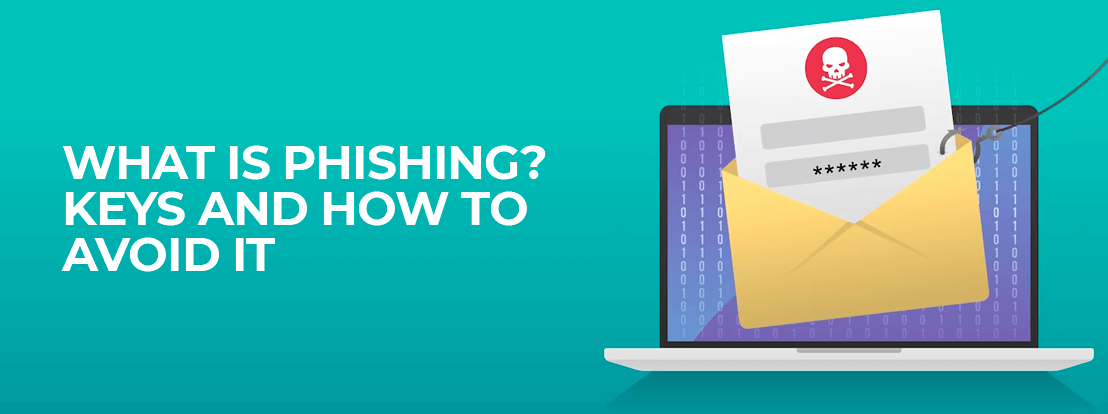The Internet is a fantastic tool in many ways, however, it also has its drawbacks and dangers. One of them is the rise of a new type of crime, called cybercrime.
Among the attacks carried out by cybercriminals is Phishing. If you want to know what Phishing is, some examples and the keys to avoid it, keep reading!
Table of contents
What is Phishing?
The term Phishing refers to the technique of identity theft in which users’ sensitive data are “fished”. This is because cybercriminals who commit Phishing, what they do is to put different traps or “bait” to deceive other users.
Generally these cybercriminals impersonate other people or organizations, so that when a user “takes the bait” can end up giving sensitive information to criminals.
The type of information that is most often obtained by this type of technique is bank details, so it is very important to know when this can happen, to detect it and not fall for the scam.
Phishing in Emails
Phishing in Emails is the most common of all. Cybercriminals send mass emails, impersonating the identity of other users or, sometimes, of banks, well-known companies, etc.
Fortunately, most emails of this type are not well prepared and we can easily distinguish them from the real ones. However, this is not always the case. On other occasions, some less experienced users, such as older people, are unable to distinguish them and fall for the bait.
Phishing on Social Networks
Another of the most common examples of Phishing is found in Social Networks. The mechanism is very similar, the difference with Phishing in Emails is that instead of happening through an email, it happens with fake Social Network profiles that send messages impersonating the identity of influential users or known companies.
This happens, for example, in the case of sweepstakes on social networks. Sometimes, some cybercriminals create a profile replicating the profile of the company that is carrying out the sweepstakes. Once done, they contact followers of that company to announce that they have won the sweepstakes and ask them for sensitive data such as their address, passwords, bank details, etc.

What is recommended to avoid becoming a victim of phishing?
As you have been able to see, cybercrime can be a great danger and Phishing is a type of cybercrime that, although it is very common, it is still very effective.
For this reason, we leave you some keys so that you can detect this type of malicious messages and you can protect yourself from these bad practices:
Be aware of the appearance
Phishing attempts, fortunately, can be generally easy to identify. One of the main characteristics to look out for is the appearance of these messages, whether they are via email, social media, SMS or a URL.
The design of these messages with others received that we know if they are official, we can see passages is generally poor. The logos are in poor quality, the use of corporate identity is disjointed and at a glance, comparing these we see that it is not real.
Check the content
The language is also generally strange. On many occasions we can see literal translations, which easily indicates that it is not an official message.
Another key indicator is the insistence on asking for sensitive data. No bank or known company will ever ask us for this type of data through these channels, much less in such an insistent way or with terms such as “urgent”, “danger”.
Check if the message warns you about the loss of your bank account or, for example, that your order will not arrive if you do not provide this information. They may also ask you for payment. This should definitely alert you.
Look out for URLs
Usually these emails or messages received by Social Networks or SMS, include a URL. Sometimes this URL looks like the official URL, however, we can see that it redirects to one that does not have the security certificate.
Therefore, whenever we see these messages we have to avoid them, directly or open them and if we do, never click on any URL.
SPAM folder
This type of actions are usually found in the SPAM inbox, either email or your Social Networks. It doesn’t always have to be a phishing message, but if it’s in this inbox, it should make us suspicious at first.
Antivirus and security updates
Finally, we recommend that you have an antivirus installed on your devices. In addition, it is important to keep your devices and Apps updated, as many updates have security improvements.
In conclusion
The actions of cybercrime and specifically those related to Phishing are very common and dangerous, given its effectiveness. This type of actions are, above all, very dangerous for certain inexperienced users, such as the elderly.
Therefore, it is important to know how to identify them correctly and avoid them, so as not to fall into this kind of traps.
Do not let them steal your data, never give online information such as passwords or bank details. No official profile will ask you for it through emails, social networks, calls or SMS.
Related Posts










Deja un comentario